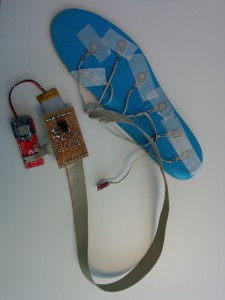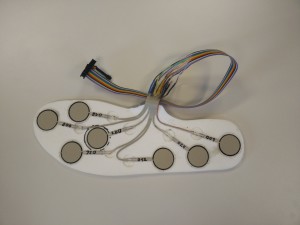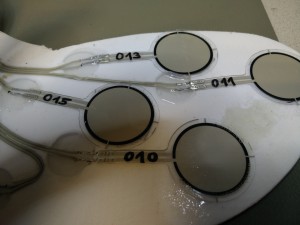The Shoe
Introduction Walking is one of the most fundamental and rudimentary motor skills that forms the foundation for several prominent activities within human locomotion. Inhibitions and impairments to otherwise healthy gait patterns hold both serious and detrimental consequences for those affected. Simple tasks, which would otherwise require little or no effort to execute, suddenly become a daunting task that demand significantly more effort and strain for completion. Therefore the diagnosis and treatment of gait disorders is a critical aspect within physical therapy. However, to accurately investigate and treat the underlying gait pathologies, requires typically highly sophisticated technology such as three-dimensional motion capture cameras and embedded force plates. However, the high accuracy of this methodology is also accompanied by large financial and spatial costs and therefore may not be readily accessible. Recently, miniaturized and wireless sensing technologies has seen a rapid development boom that resulted in its greater affordability and accuracy. Therefore such technologies have garnished considerable attention within the clinical field as an affordable and easily-accessible method for wearable mobile platforms for gait analysis. In addition to the use of such systems as a portable and low-cost diagnosis instrument, they bear the potential of being used as a portable feedback device that facilitates motor learning for gait retraining. However, current systems are only capable of generating tonal patterns that represent a person’s temporal step frequency. Despite the advantages these systems afford, representation of a person’s temporal step frequency may be insufficient for optimal gait rehabilitation. Within both the research and clinical community, movement based real-time auditory displays, known as sonification, has garnished a significant amount as plausible means for altering and rehabilitating movement abnormalities. Sonification functions as a feedback system that provides to the user an auditory representation of their movement in real-time. The current literature has already demonstrated the effectiveness of sonification as a means for improving sport performance and facilitating rehabilitation. However, the use of sonification for rehabilitating abnormal gait patterns is still relatively underexplored despite its large potential.
Goals
Based on the aforementioned demand for affordable gait rehabilitation systems, along with the current limitation in wearable mobile gait analysis platforms, the goal of the CARMA- SONIGait Project is the development of a real-time, portable, and low-cost gait sonification application for patient use in- and outside of clinical settings. Therefore the three aims of the SONIGait Team are:
- Prototype development of a pair of wireless, sensor insoles instrumented with force-sensors for real-time data transmission and acquisition of a mobile client (SONIGait).
- Present the development of a set of sonification prototypes for audible feedback on a mobile client on a mobile client in combination with the SONIGait device
- Investigate the influence of the different sonification tones in influencing spatio-temporal gait parameters
The Device
The insoles of the SONIGait device are outfitted with 7 A301 force sensors that are directly embedded into the shoe sole. These force sensors are located at the heel area and continue along the lateral part of the sole to the forefoot and metatarsophalangeal joints. This sensor arrangement allows for the calculation of several gait timing parameters as well as the rough approximations of the vertical ground reaction force and plantar force distribution.
The data collected by the sensors is then fed over a wireless bluetooth connection to an Android device smartphone that provides both visual and auditory feedback to the users regarding their gait parameters. Specifically, the device provides information regarding how much force is acting through any one part of the insole via visual and auditory means to the users in real-time.
Additionally, the SONIGait device is powered by a 3.7V lithium-ion battery supply that supplies power for a minimum of 30 minutes before recharge.


Methods
To determine the first SONIGait prototype’s effectiveness, a total of 12 participants (6 males and 6 females) voluntarily participated in our pilot study. We tested the effectiveness of the real-time sonification system to alter gait patterns through the following experimental procedure:
The first step consisted of introducing each participant to the SONIGait device and its intended purpose. Once this, along with the initial setup was completed, participants were asked to walk along an 8-meter straight walkway for a total of seven trials. Whereby they were asked to walk at a self-selected walking speed and to keep on walking constantly throughout the seven trials. This procedure was repeated six times, using one of the sonification types described above and once without sonification. The order, in which these six situations were used, was randomly assigned using a computer generated randomized procedure.
Results
The results from our study revealed that participants that received sonification feedback had reduced cadence, reduced gait velocity and increased step time compared to when they walked without any feedback. Although counterintuitive, these results hold great promise for the effectiveness of our SONIGait system. It is important to consider that the participants in our pilot study were healthy individuals that were completely absent of gait abnormalities. Bearing this in mind, it is clear that our SONIGait prototype was able to successfully draw participant attention to their own gait mechanics through the sonification feedback.
In patients with abnormal gait mechanics, increasing their attentional focus on their own gait may serve as an augmented feedback means to learn, in real-time, what they are currently doing and how they can improve their movements. The goal in doing so would be to “re-learn” how to exhibit healthier walking mechanics.
What comes next?
The results from our first SONIGait prototype displayed great promise as an affordable method for altering gait parameters. Therefore our SONIGait team is currently developing a newer prototype that builds upon and improves the effectiveness of the current system.
Our newer prototype will be outfitted with seven FlexiForce A401 force sensors compared to the seven FlexiForce A301 sensors used in the original prototype. The advantage of the newer sensors is that the insole will cover a larger surface area of the shoe and will therefore more accurately capture the associated ground reaction forces that are acting through each region of the foot. Additionally, we are continuously making improvements to the miniaturization and power efficiency of our device so that we develop a practical, affordable and user-friendly device.


